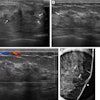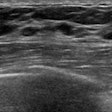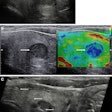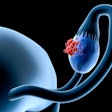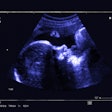
VIENNA - While the relationship between malignancy and hypervascularity is well established, vascular patterns can vary widely. So a new study from the U.K. may be a bit surprising. Ultrasound has found a robust correlation between a single vascular pattern and primary testicular cancer.
At Tuesday's scientific sessions of the European Congress of Radiology, Dr. Lucy Bushby from Kings College Hospital in London, U.K., discussed the criss-crossing vascular pattern revealed by high-frequency color Doppler ultrasound.
"Previous work has showed a general trend between tumor size and vascularity, with larger tumors being hypervascular meeting a certain criteria," she said.
"However vascular patterns were not specific enough to differentiate tumor from inflammatory disease. Neither is B-mode ultrasound alone sensitive enough to differentiate tumor from other scrotal disorders, and with the advent of high-frequency ultrasound probes, we investigated (the differentiation of) tumor from inflammatory disease," she said.
Over a two-year period, Bushby and colleagues examined 2,032 consecutive patients referred for scrotal ultrasound with a 15L8w multifrequency (8-13 mHz) linear array probe (Acuson, Mountain View, CA). The group uncovered 53 focal abnormalities in 44 patients. When a lesion was found, the patient was re-examined by two experienced operators using color Doppler mode ultrasound. The resulting clips and static images were reviewed and stored, and the vascularity was classified into types A, B, and C.
Type A lesions had no intralesional vessels (n=9); type B lesions had surrounding but no intralesional vessels (n=5); and type C lesions had intralesional vessels (n=37), which were then further divided into three subtypes:
- C1 lesions showed a criss-crossing vascular pattern (n=26)
- C2 lesions showed a disordered vessel pattern (n=9)
- C3 lesions showed complete infilling (n=2)
"Here its a type C2, there's a small hypoechoic mass and there's the disordered vascularity pattern within the lesion. C3 has a small hypoechoic mass, and there's complete infilling of the lesion," she said.
Out of the 53 lesions, there were 27 primary testicular tumors present at histology. Twenty-six of the lesions demonstrated a C1 criss-crossing vascular pattern, meaning that the C1 pattern was present in 95% of the primary testicular tumors.
"This is a highly significant result," Bushby said, adding that the single primary tumor that did not fit the criss-cross pattern turned out to be a single very differentiated teratoma that showed no intralesional vessels, and was thus classified as a type A lesion.
"The crisscrossing vessel pattern seen here in the seminoma, here in the teratoma, while not allowing differentiation of cell type, was seen in 95% of the tumors, and does have high statistical significance," Bushby said, adding that improved probe technology has enabled the visualization of an important distinguishing feature of primary testicular carcinomas.
By Eric BarnesAuntMinnie.com staff writer
March 7, 2002
Related Reading
Renal cancer detection on the rise in US, January 15, 2002
Ultrasound aids mammography in breast cancer diagnosis, December 3, 2001
Ultrasound positions prostate cancer patients for therapy, November 7, 2001
Copyright © 2002 AuntMinnie.com


